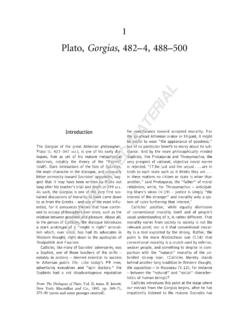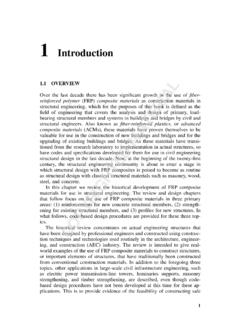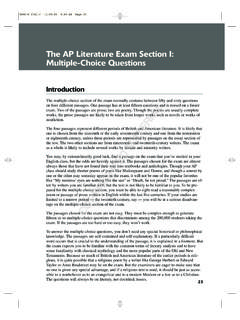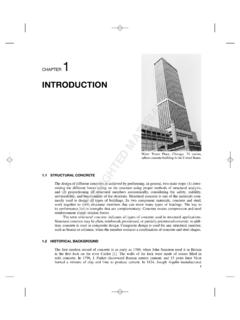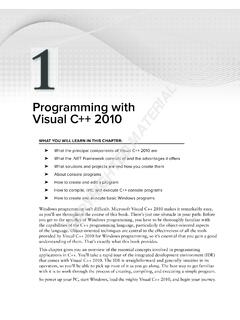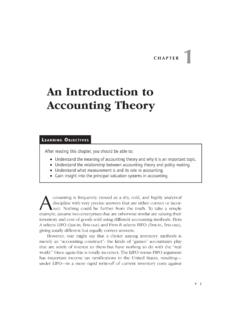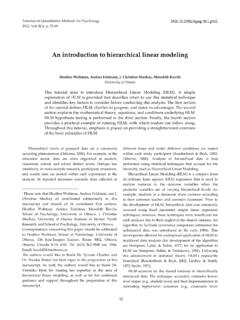Transcription of Introduction to Furniture Design - Wiley
1 1 DICTIONARY AND ENCYCLOPEDIC sources use words like accessories, equipment, and movable objects to defi ne Words can describe the performance and physical characteris-tics of Furniture , but those who Design , make, and use Furniture know that Furniture Design extends far beyond dictionary or encyclopedic defi nition. Furniture Design concepts lead to the production of useful items that result in tactile experiences (Figure ). In nearly every case, Furniture is something people experience through direct human engagement. In addition, one s understanding and knowledge of Furniture evolves with use and over Furniture relies on intuition, judgment, Design skills, engineering principles, and knowledge in a broad range of disciplines helpful with problem solving.
2 Designing Furniture requires inspiration, a concept or idea, and the commitment to give pleasure to those who use inevitable shift from designing Furniture to fabricating Furniture generates an appre-ciation for both the obvious and subtle ways in which making can infl uence the Design process. Through the process of making Furniture , one will learn about hand, power, and digital tools, material properties and working methods, assembly processes, and the time required to fi nish a project. Fabricating Furniture demands precise skill and workmanship and often results in a sense of craft for those directly involved in the process.
3 Making furni-ture does not necessarily guarantee an ability to Design Furniture , but it will result in an expanded knowledge of materials, tools, and joinery, which in turn generates a broader appreciation and respect for Furniture Design is deeply rooted in the human condition. It is a social science that belongs to the humanities, an applied art that draws upon many Design disciplines, and is dependent upon a working knowledge of materials and fabrication techniques. It is a holis-tic and interdisciplinary fi eld of to Furniture 118/09/12 10:11 AM18/09/12 10:11 AMCOPYRIGHTED MATERIAL2 Introduction to Furniture Design Before delving into the nature of Furniture Design , consider the terms Furniture and Design and refl ect upon the fundamental and symbiotic relationships bound in the meaning and etymology of these two noun 1.
4 The movable articles that are used to make a room or building suitable for living or working in, such as tables, chairs, or desks. 2. the small accessories or fi ttings that are required for a particular task or function: door many accounts, Furniture includes a broad range of moveable objects organized in four main categories: Human body support devices (Figures and ) Surfaces and objects to support various activities (Figures and ) Storage and display pieces (Figures and ) Spatial partitions3 (Figures and ) Furniture pieces are designed and fabricated to assist in the many ways people sit and rest, work and play, organize or display items, and partition space.
5 This view suggests a broad utili-tarian framework, in which function is perceived to be the primary intended purpose of Furniture . Although function, utility, and social use are important aspects of the perfor-mance of Furniture , rarely does function alone inspire great Design . Furniture Design draws upon ideas of beauty, principles of Design , theory, material properties, fabrication technologies, business economies, environmental Design matters, and the surrounding spatial context in which it is placed, all of which are integral and intertwined with function, utility, and social use.
6 Considerations that infl uence what we think about and feel regarding Furniture Design include: Aesthetics (the meaning of form) Historical precedent (examples from the past) Principles of Design ( , unity, harmony, hierarchy, spatial order)Figure The Knit chair in use. Designed by Emiliano Godoy (2004). This chair was awarded a Bronze Leaf at the International Furniture Design Competition Asahikawa 2005 in Asahikawa, Japan. Photography courtesy of John Curry, GODOYLAB, 218/09/12 10:11 AM18/09/12 10:11 AMFurniture 3 Function and social use (ergonomics, comfort, proxemics) Design processes (sketching, iterative overlays, model studies, digital modeling, full-scale working prototypes, collage assemblies) Material (classifi cation, characteristics, properties, availability, cost) Fabrication processes (hand, power, digital) Environmental Design matters (sustainability, renewable materials, off-gassing) Surrounding context (the spatial setting for Furniture ) Professional practice (economic, legal, and business decisions)
7 A goal in designing Furniture is to consider all Design aspects in a comprehensive and integrated manner, while maintaining focus and critical engagement upon the primary concepts and ideas that inspire Reclining with the chaise longue at Villa Savoye, Poissy, France. Photography by Stephan Dober, Plan side and front views of chaise longue (known as LC/4) designed by Charlotte Perriand, Pierre Jeanneret, and Charles- douard Jeanneret (Le Corbusier) (1928 1929). Originally manufactured in chrome-plated steel, fabric, and leather by Thonet Fr res, Paris, then by Cassina, Italy since 1965.
8 22 inches wide; 63 inches deep; 28 high ( cm wide; 60 cm deep; 73 cm high). Drawing by Ashley Hermann, 2006, courtesy of Jim 318/09/12 10:11 AM18/09/12 10:11 AM4 Introduction to Furniture Design Figure Outside caf tables and chairs, Paris, France. Photography copyright William A. Yokel, Drawing table, designed by Robert Mallet-Stevens (1927) for professional use in his Paris offi ce. Made with tubular metal, poplar wood, and hard lacquer paint. Photography by Jim Postell, Case goods (cabinet and bookcase) designed by Mogens Koch, fabricated by Rud. Rasmussen (since 1932), Copenhagen, Denmark.
9 Photography courtesy of Rud. Rasmussen, Denmark, Cabinet, designed by Ettore Sottsass (1948 1949). Made with lacquered wood and brass-plated tubular steel. Photography by Jim Postell, considerations can channel the development and refi nement of Design ideas but rarely inspire them. Utility is grounded by specifi c categories of social use, associated with the broader classifi cations of building and zoning nomenclature. In this book, catego-ries of social use 418/09/12 10:11 AM18/09/12 10:11 AMFurniture 5 Figure Furniture as space space as Furniture . Dupont Corian exhibit, designed by SOM, 2005.
10 Photography by Brian F. Davies, Living Sculpture in nine components, designed by Verner Panton (1970 1971). Made using mass-polyethylene, with an internal armature supported by expanded polystyrene foam, upholstered in wool. Overall size: 86 inches wide; 201 inches deep; 169 inches high (220 cm wide; 510 cm deep; 430 cm high). Fabricated by Mira-X. Photography by Jim Postell, 2011. Health care Hospitality Institutional Offi ce Recreational Religious Residential Retail StorageBroad categories of social use are dependent on particular activities and affected by specifi c circumstances, which are nearly always infl uenced by place, occupancy, and time.
